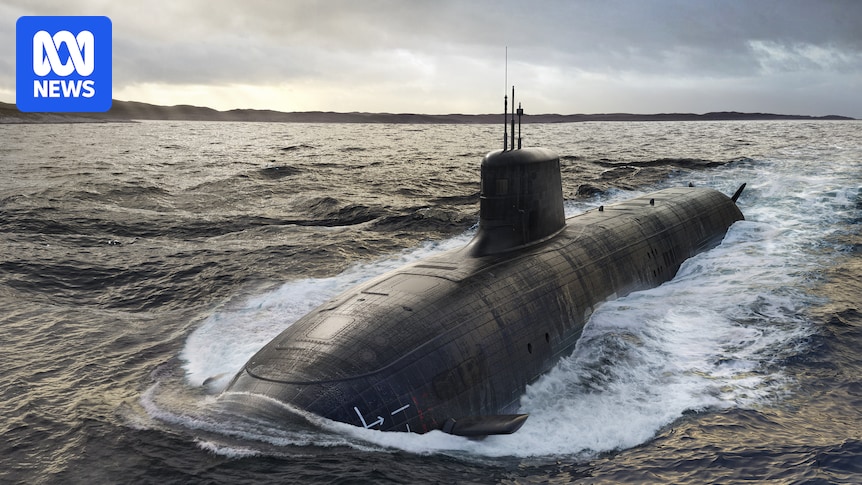The United Kingdom’s top AUKUS envoy has backed Australia’s “massive” contributions to the defence technology pact, saying the agreement delivers “enormous value” to the US and its two military allies.
The US Department of Defense caught Australia by surprise in May when it kickstarted an internal snap review of AUKUS, saying it wanted to ensure it was aligned with Donald Trump’s “America First” agenda.
Former top British civil servant Sir Stephen Lovegrove — who conducted the UK’s own review of the AUKUS pact before being appointed as Prime Minister Keir Starmer’s special envoy — is visiting Australia for talks with senior officials and top brass.
He told ABC’s 7.30 program that he was “not worried” about the Trump administration’s review, because AUKUS enjoyed “huge” support in Washington DC, and delivered major benefits to the US.
“The US Navy is right behind it; I speak to them a lot. The State Department is very much behind it [and] many players in the Defence Department are completely engaged in AUKUS and everything it brings to the US,” he said.
“So I’m pretty comfortable that we’ll end up with the right answer for the US, Australia and the UK — this is a critical, critical program.”
The senior Trump administration official conducting the AUKUS review, Elbridge Colby, has warned the US will only be able to sell Virginia Class submarines to Australia under AUKUS if it succeeds in lifting its own pace of production to at least two boats a year.
Britain launches AUKUS parliamentary inquiry amid ‘geopolitical shifts’
Australia is already pouring billions of dollars into the US submarine industrial base under AUKUS, but Sir Lovegrove said Australia’s promise to develop a submarine maintenance hub in Western Australia would also make it easier for US Navy to keep more boats in the water.
“Clearly one of the things that they’re going to be looking at is whether or not they’re building [the Virginia Class submarines] fast enough, but one of the other crucial things they’re going to be looking at is the massive contribution that Australia is making by allowing Western Australia to be used as a maintenance and sustainment hub,” he said.
“And that will mean that there are many more Virginias which are capable of being put to sea. So this is a real win-win for all of the nations.”
Under AUKUS both US and UK submarines will begin to rotate through the HMAS Stirling naval base from as early as 2027, and the federal government has promised to plough more than $120 million into transforming the nearby Henderson shipyard into a precinct which can service nuclear-powered submarines.
Henderson shipyard to become defence precinct
But earlier this week the former US Navy Secretary Richard Spencer warned that Australia needed to move more quickly to upgrade both HMAS Stirling and the Henderson shipyard, to ensure they were ready by 2027.
“We need to start moving dirt, putting the infrastructure in, because 2027 is going to be here within the blink of an eye,” he told The Nightly.
Sir Lovegrove said he would tour Henderson on Thursday, and that he “was not really in a position” to comment on whether Australia needed to ramp up investment in the shipyard until after he’d visited it.
But he said that “schedule was king” when it came to AUKUS and that all three nations under the pact “need to be acting at the speed of relevance”.
“A crucial part of the whole of the AUKUS program is to make sure there are the maximum number of existing Virginia boats in the water doing their very important job,” he said.
“If that requires new investment in Henderson, that needs to be looked at pretty carefully.”
Australia will join other countries, like France, in adding nuclear-powered submarines to its fleet. (Wikimedia: French Navy)
While Sir Lovegrove’s review of the AUKUS pact has not been publicly released, the envoy told 7.30 that he found commitment to the pact across the UK was “as strong as ever”.
“The challenge I think as much as anything else is execution now. It’s actually doing what we said that we were going to do in the optimal pathway,” he said.
“We are on track to hit the kind of timetables that we need to be able to hit [and] I made a variety of recommendations about the way in which we could improve and speed things up.”
He also said he was confident that the United Kingdom would be able to meet its own commitment to rapidly speed up submarine production, despite sharp challenges across infrastructure, sustainment, and workforce development.
“We’re going to be putting about 6 billion British pounds ($12.5 billion) of UK taxpayer money into [our main shipyard] before the end of the decade, another half a billion or so into one of our key steelworks,” he said.
“And that will give us the extra capacity to be able to hit those kinds of targets.”
